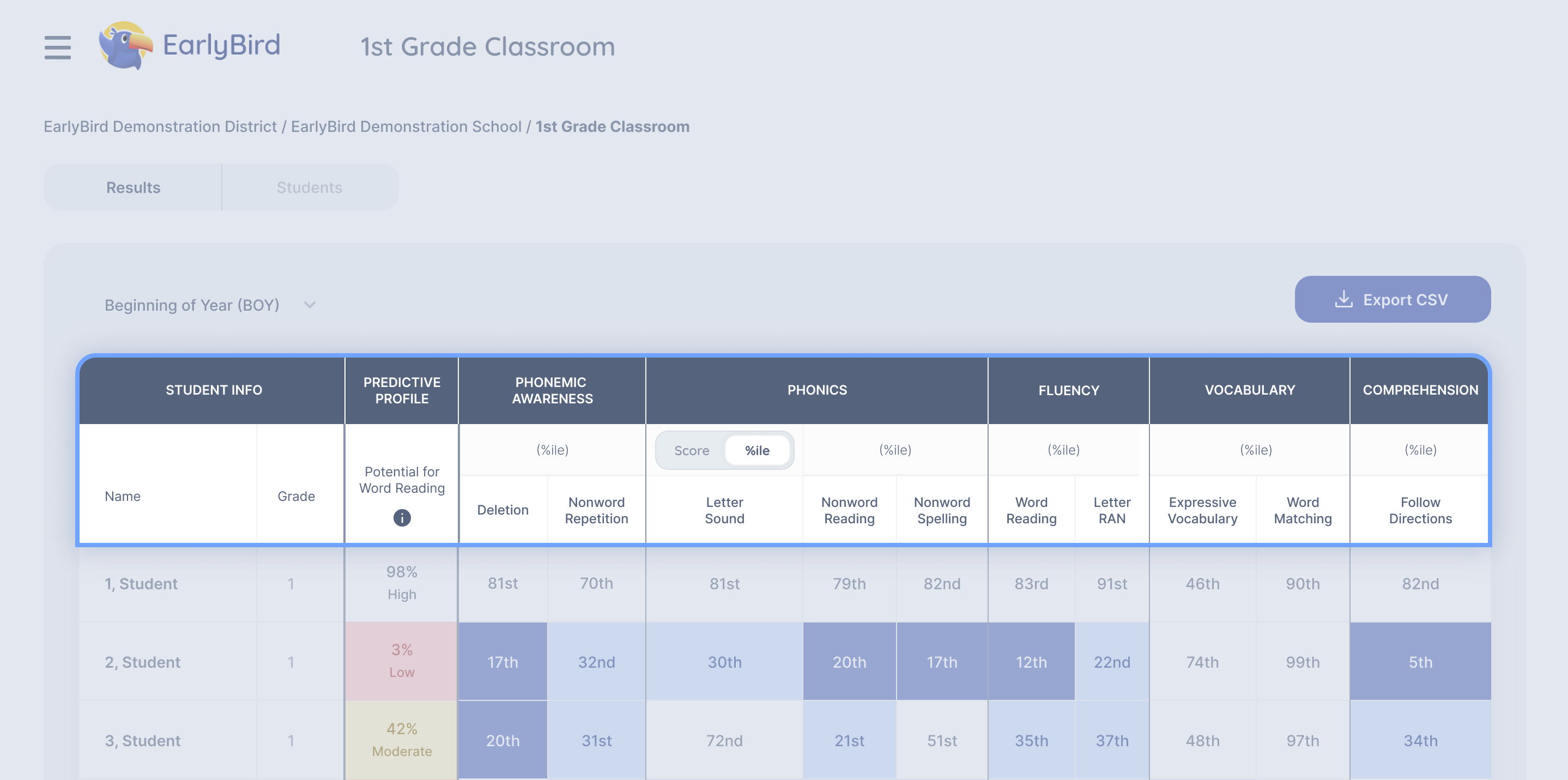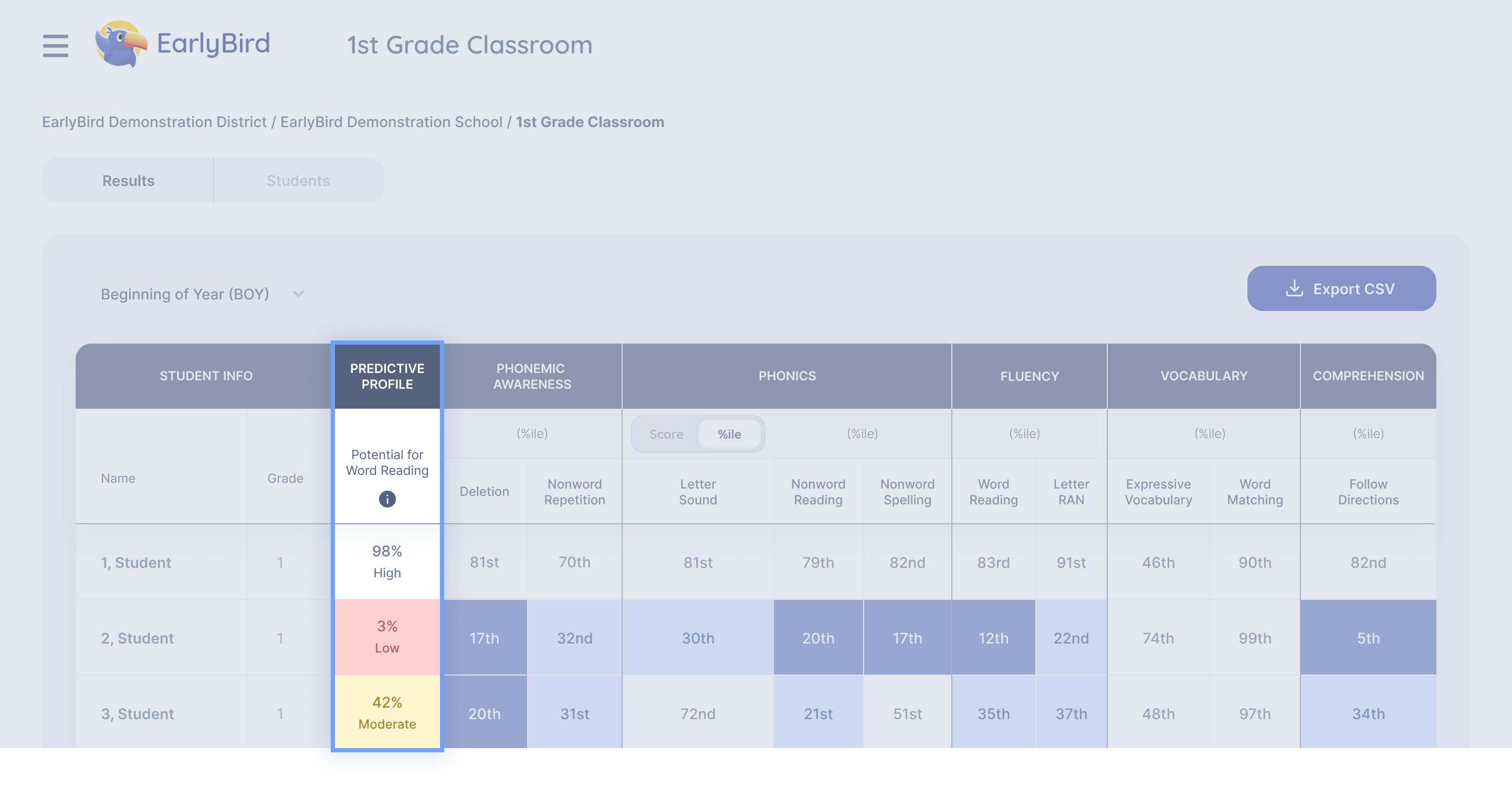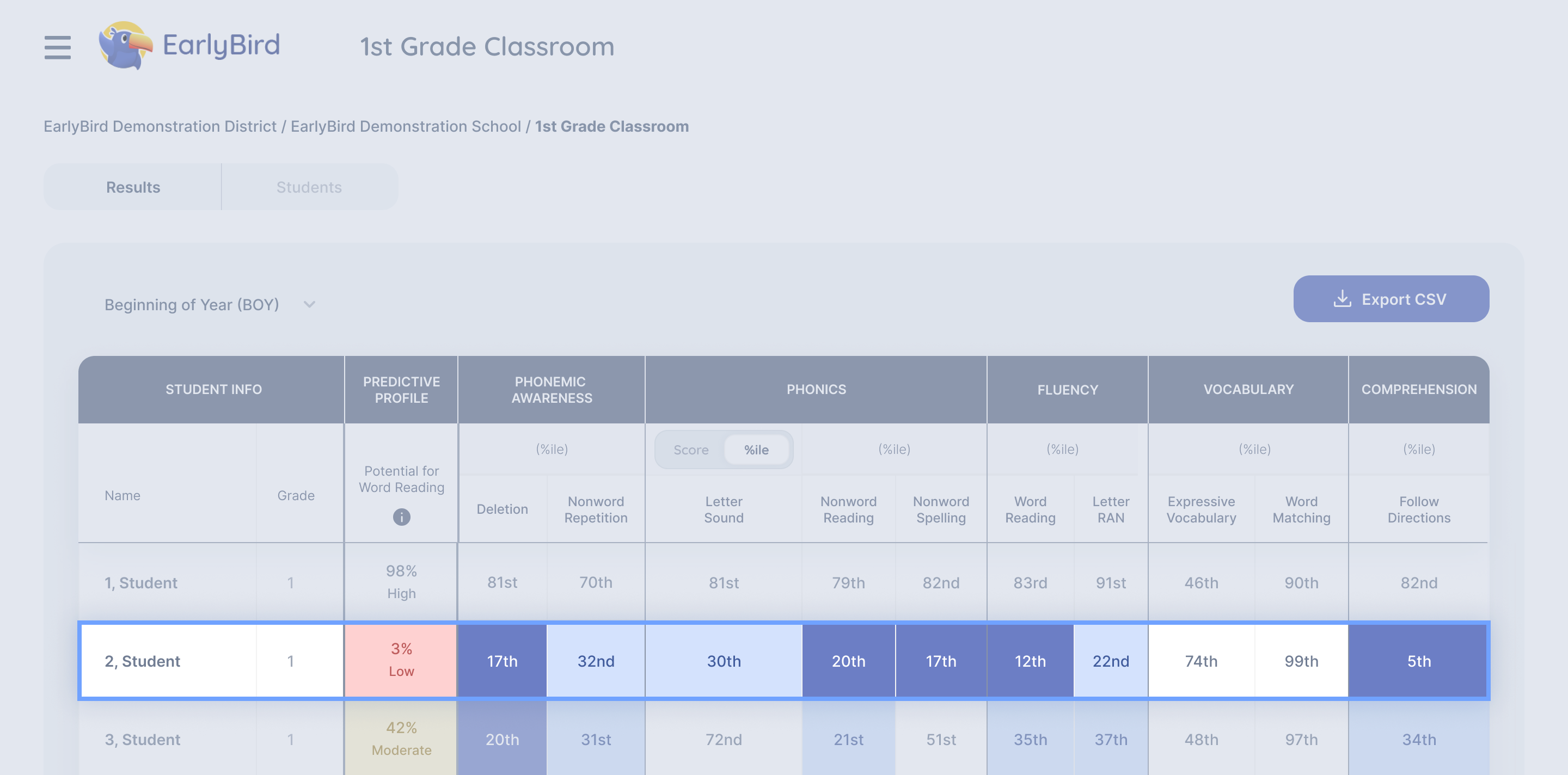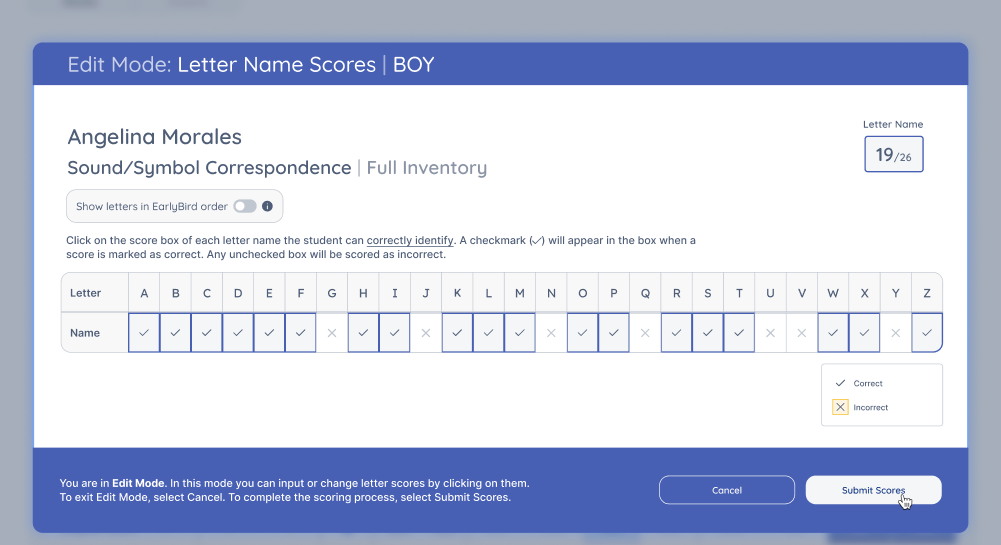NEWS – Announcing platform improvements designed to make it even easier for educators to take action

EarlyBird was founded to help schools and families identify students most at risk for dyslexia—before reading struggles even develop. Applying research from our co-founders, Dr. Nadine Gaab and Dr. Yaacov Petscher, we built an assessment that focuses on early detection: specializing on pre-readers, with a game-based assessment that streamlines data collection.
The results have been groundbreaking: more than 72% of educators say they’ve identified students they would otherwise have missed and EarlyBird is being used by schools and families across 25+ states.
📣 Hear Dr. Gaab describing what child brain development tells us about early detection

But as we’ve grown, so too has our understanding of the problem: no longer do educators just want to know who is at risk for dyslexia and other reading struggles… they also want to know how to intervene. And unlike many of the screeners on the market, we’re constantly adding resources to do just that: give educators the data and instructional tools they need to ensure every student is on track to read by third grade.
EarlyBird was built to prevent reading struggles like dyslexia. This year, we’re evolving our EarlyBird Dashboards to make it even easier for educators to not only identify those most at risk for reading struggles—but take immediate, scientifically-sound action.
Explicit alignment to the Five Components of Reading
Grades impacted: All grade levels (PreK, Kindergarten, 1st, and 2nd Grades)
At EarlyBird, we say “research is in our DNA.” Reading science has always guided the way we’ve designed, validated, and communicated about our subtests—but now we’re making the relationship even more transparent for users.
Beginning in August 2024, the EarlyBird dashboard and student profile pages will be visually organized to reflect the five essential components of reading as outlined within the National Reading Panel: phonemic awareness, phonics, fluency, vocabulary, and comprehension.

👀 Click to see the full suite of subtests by grade level
EarlyBird’s subtests have always aligned with the science of reading, but these changes make it easier for districts implementing structured literacy practices to maintain common language between administration, educators, and families.
Streamlined predictive profile
Grades impacted: 1st & 2nd Grades in 2024-25; Kindergarten in 2025-26
In May 2024, we announced an exciting new partnership with the Florida Center for Reading Research (FCRR) to bring groundbreaking research from the Reach Every Reader (RER) project into the EarlyBird platform. As part of this roll-out, we’re updating our Grade 1 and Grade 2 subtests and predictive algorithms to reflect learnings from the latest RER validation study—specifically, the importance of the Word Reading subtest for predicting end-of-year reading outcomes.
Beginning at BOY for 1st and 2nd Grade classrooms, partners will see a simplified predictive profile that uses a single flag: Potential for Word Reading (PWR) based on a student’s performance on the updated Word Reading subtest.

The Potential for Word Reading score, shown as a percentage, offers educators an easy way to identify students based on their probability for becoming successful readers at the end of the year without intervention. In addition to this percentage, educators will also see three levels (low, moderate, high) which are color-coded for quick analysis. These cutpoints make grouping students for MTSS and mandated state reporting even simpler than before.
Identifying strugglers by subtype
Grades impacted: All grade levels (PreK, Kindergarten, 1st, and 2nd Grades)
Knowing which students are likely to struggle is half of the puzzle—knowing how to intervene is critical too. EarlyBird’s predictive profile is meant to be used in conjunction with the robust subtest data to identify subtypes of struggling readers and tailor instructional grouping.
Educators can begin by identifying students marked as “Low” in their Potential for Word Reading, then apply the quadrant model to group students into different profiles based on the Simple View of Reading.
For instance, consider a student marked with a Low Potential for Word Reading score who scores high in Language Comprehension but low in Word Reading—scores that fit the typical pattern for dyslexia. An educator might then use student groupings to tailor instructional strategies accordingly.

While the Potential for Word Reading score helps educators prioritize support, the subtest scores within the dashboard provide guidance on what skills need to be built. When paired with the aligned resources in the Next Steps Resources hub, educators have a one-stop-shop for personalizing reading instruction.
Prioritizing user feedback for testing flexibility
Grades impacted: PreK, Kindergarten, 1st Grade (BOY Letter Sounds Only)
Walking the line of comprehensiveness without overassessing is a balancing act. At EarlyBird, we offset the burden of data collection with auto-scoring that saves teachers time while reducing bias in the grading process. But thanks to educator feedback, we’ve learned that most users already complete their own letter name/letter sound inventories and would prefer to reference those scores rather than spending additional instructional time having students complete the auto-scored version in EarlyBird.
In order to avoid overtesting while also improving data quality, we have removed the Letter Name and Letter Sounds subtests from the standard gameboards and provided optional printable versions in the Next Steps Resources. Beginning this fall, educators will be directed to input their student’s scores manually into the EarlyBird dashboard.
This change means schools can now use their existing Letter Name/Letter Sound assessments without being forced to double test students. Once entered, normed percentile scores will appear in the dashboard and student profile views so that educators can use the full breadth of information to analyze and group their instructional support.

Expanded professional learning & aligned resources
Grades impacted: All grade levels (PreK, Kindergarten, 1st, and 2nd)
The new, enhanced EarlyBird dashboards are built to make schools’ early literacy data more actionable—but we’ve made other improvements too that are already live: personalizing our professional learning offerings and adding new printable subtests for Oral Reading Fluency and Reading Comprehension to the Next Steps Resources hub.
All of these changes are thanks to countless conversations and feedback provided by educators, administrators, and parents. If you’re a current partner, expect additional communication soon from your Customer Success Manager with tips and resources for supporting your staff using the EarlyBird program. Immediate questions? Check out the FAQ below or reach out to us at support@earlybirded.wpenginepowered.com.
🔍 See the full list of new platform enhancements and product updates here
Frequently asked questions

Q: Which grade levels will now have a single Potential for Word Reading (PWR) score?
For the 2024-25 school year, only the 1st and 2nd grade dashboards will reflect the single Potential for Word Reading score and removal of the other predictive flags.
We are rolling out these changes gradually, with the intention of updating Kindergarten to match for the 2025-26 school year (along with new Reach Every Reader content). PreKindergarten classrooms will not use a PWR score but continue to offer a Reading Readiness flag at the EOY benchmark period.
Q: How will this new Potential for Word Reading flag in Grade 1 and Grade 2 impact mandated state notifications?
Grade 1 and Grade 2 students in the red “Low” PWR group should be reported to states as those significantly below benchmarks or flagged for dyslexia risk.
Q: How are the Grade 1 & Grade 2 Potential for Word Reading cutpoints for “Low,” “Moderate,” and “High” determined?
The cutpoints are designed to predict a student’s future score on the end of year (EOY) KTEA-3 Letter and Word Recognition, based on their most recently demonstrated skills for Word Reading.
Specifically, their PWR score indicates:
- “Low performance” = likely ≤16th percentile on KTEA-3 Letter and Word Recognition at EOY
- “High performance” = likely ﹥ 40th percentile on KTEA-3 Letter and Word Recognition at EOY
- “Moderate performance” = all other students who did not meet the “low performance” or “high performance” criteria
Q: How is the Potential for Word Reading algorithm different from the Word Reading subtest score?
Word Reading subtest scores give educators the normed percentile for that time period (BOY, MOY, or EOY) and indicate the child’s current ability while the PWR score predicts the child’s likely EOY word reading proficiency as it compares to the KTEA-3 Letter and Word Recognition.
Q: What if a student is marked “High” in their Potential for Word Reading score but low in some of their subtests (i.e. specifically within phonemic awareness, phonics, fluency, vocabulary, comprehension)?
We always encourage educators to focus attention to specific skill deficits; the purpose of the PWR score, which is only driven by Word Reading subtest scores in 1st Grade and 2nd Grade, is to quickly screen and differentiate between those students who will likely be fine with word reading at EOY (“high (PWR) performance”) vs. those who may need additional support.
It is a tool for prioritization, but subtest data should direct action—and we’ve built our Next Steps Resource hub to align to subtests explicitly for this reason.
Q: Do educators have to enter their students’ Letter Name & Letter Sounds scores or can we skip these subtests?
We highly recommend manually entering students’ Letter Name & Letter Sounds scores for PreK, K, and BOY 1st Grade in order to get the most out of the EarlyBird dashboard. Though these do not factor into the Potential for Word Reading score for 1st Grade, they do represent the majority of data within the “Phonics” component of the PreK and Kindergarten dashboards. The Kindergarten Letter Sounds subtest score also factors into the Kindergarten MOY Potential for Word Reading score.
Once scores are entered, they are shown as normed percentiles—allowing educators to interpret their students’ results and prioritize additional support.
Ready to use EarlyBird for the 2024-25 school year?

EarlyBird is the most science-based early literacy assessment on the market—built to help school districts prevent dyslexia through gameplay.
- If you’re interested in bringing EarlyBird to your school, check out our 10-minute walkthrough here and get in touch!
- If you are a current partner, contact your Customer Success Manager or email support@earlybirded.wpenginepowered.com to manage your renewal or get a quote for additional grades.
